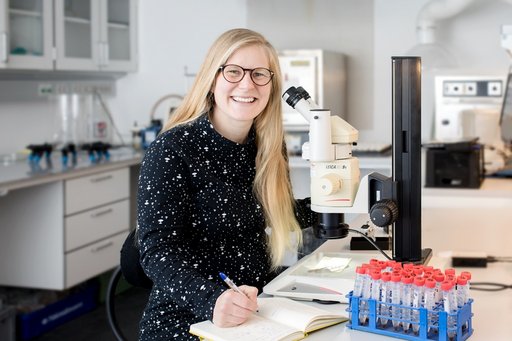Astrid Strunk

Sediments of microfossils can now be dated more accurately
Astrid Strunk has reconstructed how the Ice Sheet in Northern Greenland reacts to climate change. She has also improved some of the methods for carbon dating.
Af Filip Graugaard Esmarch
When geologist Astrid Strunk started on her PhD project, her main objective was to reconstruct the movements of the Greenland Ice Sheet in parts of Northern Greenland. There were still some blank spots on the geological world map. And being a practical-oriented explorer, she went on polar expeditions, collected bedrock and lake bed samples only to stumble upon a problem.
“When you estimate the age of sediments on a lake bed, you normally date them using macrofossils, particularly plant residue visible to the naked eye. Only, there are no plants in Northern Greenland, making it harder to date sediments. So, I started looking for microfossils, plant residue the size of sand grains or smaller,” explains Astrid Strunk.
In that way, her project evolved into also dealing with method improvement. By including knowledge from other fields, she discovered that she was actually able to refine the methods quite substantially when it came to carbon dating the so-called bulk samples, or to put it in layman terms: a spoonful of mud from the lake bed.
Eliminating the sources of error
“When you lack macrofossils to date, you will typically date the content of the entire bulk sample. However, this produces a very inaccurate result since the carbon dating represented by the sample is a mix of all its particles,” explains Astrid Strunk, and continues:
“So, I started looking at where the carbon in my samples came from. Did it come from 10,000 year-old plants which were the desired goal of my dating efforts? Or was it 100,000 year-old humus that would make my sample seem older than when the sediment was actually deposited?”
In her thesis, she presents a set of methods that to a large extent makes it possible to eliminate the sources of error. To reach that far, she had to apply geophysics, biology and computer modelling. In future, new methods may become widely used.
“The issue of having no ideal fossils to date, i.e. macrofossils, is not just something you encounter when you research the North Greenland Ice Cap.
You might as well encounter it as a biologist in Venezuela or as an archaeologist in Africa. They will also be able to use these methods”, says Astrid Strunk.
The ice is melting rapidly
By applying these and other methods, she successfully mapped past ice movements in a part of Northern Greenland. By looking at how much and how fast the ice melted after the last Ice Age, you can estimate how the ice will melt during the current global warming. And regrettably Astrid Strunk has some bad news for those hoping for a modest rise in sea levels.
“The computer models that have previously been used for Northern Greenland turned out to underestimate the melting. I found that the ice was actually larger than previously assumed and had melted much faster than anticipated,” she explains.
Astrid Strunk currently works in a postdoc position at the Danish National Museum, where she reconstructs the Southern Greenland climate during the Viking Age.